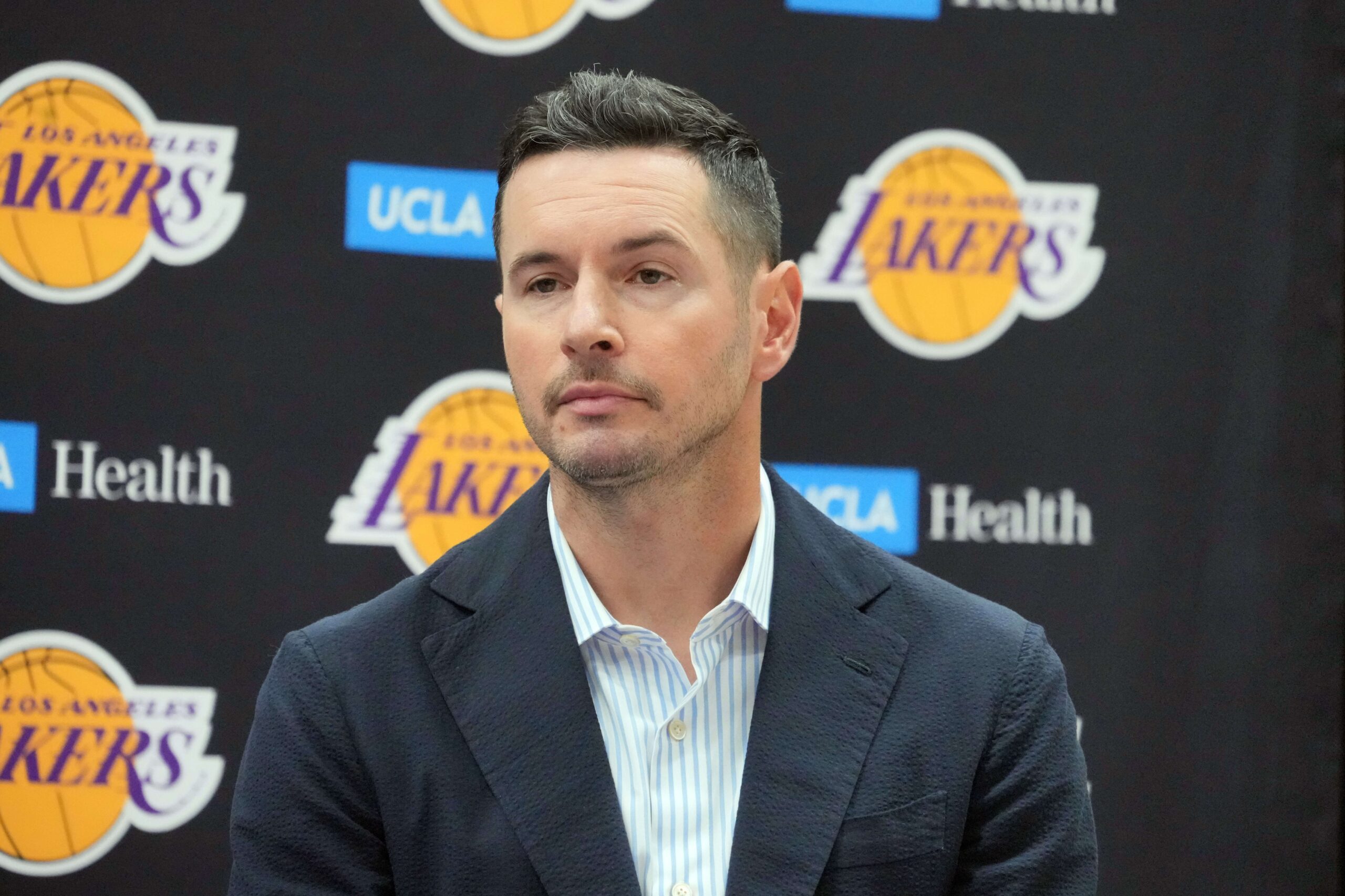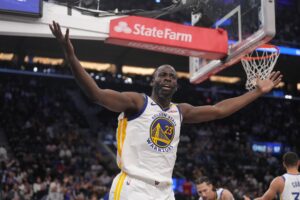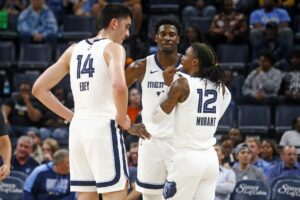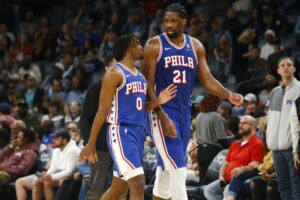The Lakers wrapped up preseason action with a road loss to the Warriors, with many fans expressing tempered excitement for their 2024-25 campaign. The players—particularly the returners—have shown a level of comfortability under head coach JJ Redick, buying into his philosophy and expressing optimism toward his leadership and system.
One recent storyline to watch was how this roster would adjust to a new and innovative game plan, in addition to a sense of structure that was, arguably, absent last season. Fans got a taste of that in preseason, but there are two areas worth focusing on as the purple and gold geared up for the games that count.
Lakers Preseason: How LA Executed Redick’s Top Two Tenets
Background
When Redick was introduced as LA’s new leading man, he expressed a desire for the Lakers to improve in two key areas: threes and offensive rebounds. For someone who has an analytics-centered approach as part of his coaching beliefs, the previous numbers do not lie—the Lakers have historically struggled in both areas.
The team’s lack of perimeter prowess was well-chronicled over the last few seasons. Last year, though they ranked eighth in regular season three-point percentage (37.7%), they were in the bottom third of threes made per game (11.8, 24th in the NBA). Their woes continued into the playoffs. The Lakers shot 29.9% from deep in the first round against Denver, making 11.5 of their 38.5 attempts per game. The Athletic’s Jovan Buha added:
“The Lakers have been a low-volume 3-point team in the James-Davis era. They have ranked in the bottom 10 in 3-point attempts per game in four of their five seasons together, including just 28th last season.”
In terms of crashing the glass, the Lakers were dead last in offensive rebounds, with an average of 8.2 per game. Similar to their shooting, those numbers also faltered against the Nuggets—a team that was better in not only competitiveness but in size as well. LA grabbed 7.4 offensive rebounds per game against Denver, ranking 14th among all 16 playoff teams. The silver lining here, though, is that they were third in defensive rebounds per game in the postseason, pulling down an average of 33.2 in that span.
Three-Point Shooting
The Lakers’ emphasis on three-point shooting should have been obvious given their coach’s playing background, but it was even more evident in their preseason opener. The team was unafraid to fire from the perimeter, hoisting 32 threes against the Timberwolves—but nailing only ten of them (31.7%). That trend stayed true in the middle of preseason action; Buha wrote that the Lakers “averaged 38.7 3-point attempts per game, which ranks 17th in the league. The Lakers have attempted at least 32 3-pointers in all three preseason games — more than they averaged last season — and more than 40 in back-to-back games.”
In the end, the team still attempted a noticeably high number of threes per game (38.5) across six preseason contests—18th in the league. However, they also made a mere 11.5 per game in that span—a mark of 29.9%.
Redick has explicitly stated how much he wants the team’s perimeter shooting to improve, saying:
“I would like us to average five or six more 3s a game. But you have to be conscientious about how we’re generating those 3s. I actually think we’ve done a pretty good job of getting good looks. … I like the mindset overall to shoot when set — and shoot good 3s.”
Given that the Lakers shot 31.7 threes per game last season, their current mark is a good sign for growth. The makes, on the other hand, should hopefully come with time.
Players That Can Help
Redick has already implored the team’s stars, LeBron James and Anthony Davis, to shoot more threes. They have since responded accordingly, albeit with limited sample sizes. Davis may have only shot 29.4% from distance, though his highlight came in a 35-point outburst where he went 4/9 from deep. James, who shot a career-high 41% from three last year, shot an impressive 57% from three in preseason—even if it came on 8/14 shooting. Both players have always spaced the floor throughout their careers, but they must be the catalysts for improving the Lakers’ chances from three-point range.
Rookie Dalton Knecht will have a chance to excel for the Lakers as he builds on a strong preseason. Tabbed as a steal of the 2024 draft, the 17th overall pick proved he is a threat from distance, translating a key skill that earned him SEC Player of the Year honors. His performance in the preseason finale—35 points on eight triples—seemed to solidify his standing as a rotation player for LA.
Finally, D’Angelo Russell, who holds the franchise record for most threes in a season, will look to build on his successful shooting this year. Russell has already proven his abilities as a scorer, even through growing pains of inconsistency, and Redick believes the veteran point guard could have a “career year.” While Redick admitted stats may not factor into that assessment, a standout campaign from beyond the arc can significantly help Russell’s case.
Offensive Rebounding
The Lakers also improved in crashing the glass in preseason, finishing ninth in offensive boards per game (12.0; tied with the Pacers). Those extra opportunities led to an average of 12.3 second-chance points per game, higher than the 10.5 they registered last season.
LA has notably had issues finding help in the frontcourt, and an overcrowding of guards won’t solve that problem. However, it seems the team has heard Redick’s rebounding goals loud and clear. The feat was more impressive considering their lack of size up front and the prolonged absences of forward Jarred Vanderbilt and center Christian Wood.
The Lakers’ rotational guards—Russell, Gabe Vincent, Austin Reaves, and Max Christie—could always pick up the slack and work for second-chance points, and there’s no doubt they’re willing to do it. Still, there are other Lakers who have embraced offensive rebounding, ones who can help against stronger, taller competitors.
Corner Crashers Crew.
All Offseason, JJ Redick emphasized Offensive Rebounding & guys Corner Crashing.
Here are a few good examples of that from the Warriors game via Max Christie, Dalton Knecht, and Austin Reaves. pic.twitter.com/j0Z6gR7uoA
— Lakers Legacy (@LakersLegacyPod) October 17, 2024
Players That Can Help
Similar to three-point shooting, Anthony Davis will still be vital on the offensive glass. He averaged 3.1 offensive boards per game last season, right around his career average of 2.7 in that category. He has always been an interior threat as a scorer and defender, but giving the Lakers more chances to score—especially with Redick’s desire to use him as an offensive “hub”—will be critical for the team this season.
The same can be said of his backup, Jaxson Hayes, who has expressed a desire to improve on the glass this season.
“I want to step up my rebounding a little bit this year. Then just a little bit on the offensive end, too. Not look to be so, I mean still be team-oriented, obviously, but a little more aggressive on the offensive end. I feel like that will help myself and help the team a little bit just getting more open shots for us. Really, just here to do whatever they need me to do and be that glue guy still.”
However, the biggest piece of the puzzle may be Rui Hachimura, who Redick has frequently brought up as a source of rebounding power this upcoming season. Hachimura—who averaged 4.8 RPG last year—has echoed the same sentiment:
“I feel like my body is stronger and I can be more physical especially, like you said, on the glass being on the offensive rebounding stuff. That’s another thing that I talked with Coach and he wants me to do more. Especially last year I wasn’t really doing it so I think this year I can mix it up with that.”
With Hachimura’s recent play—including nine rebounds (two offensive) against the Warriors—he is on the right track for being a threat on the boards this upcoming season.
The Last Word
Redick’s words are slowly but surely translating into actions. Fans will get a clearer picture of his philosophy once the regular season begins, but even in the small sample size, the Lakers have already shown a marked shift in areas that had plagued them over the years.






